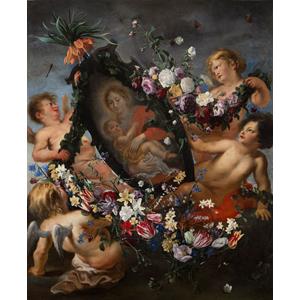DÉTAILS DE L'IMAGE

Klaas Muller
Daniël Seghers (Antwerp, 1590-1661) and Cornelis Schut (Antwerp, 1597-1655)
Portrait of the Virgin and Child, supported by Cherubs with a Flower Garland
Oil on canvas
127 x 104 cm
Provenance: Collection of Willem de Blasere, Lord of Hellebus, Ghent, circa 1635, and recorded in Seghers’ inventory as n° 135; Galerie Marcus, Paris, 1970-1974; Private collection, Belgium
Literature: Diary of Daniel Seghers in W. Couvreur, ‘Daniel Seghers’ inventaris van door hem geschilderde bloemstukken’, in Gentse bijdragen tot de kunstgeschiedenis, vol. XX, 1967, p. 112, n° 135; M.-L. Hairs, Pour un tricentenaire, D. Seghers, in revue Belge d’archéologie et d’histoire de l’art, Liège 1960; M.-L. Hairs, Dans le sillage de Rubens, les peintres d’histoire anversois au XVIIe siècle, Liège 1977, p. 213; M.-L. Hairs, The Flemish Flower Painters in the XVIIth Century, Brussels 1985, pp. 125–29, cat. n° 33, a detail reproduced p. 130; G. Wilmers, Corneli Schut (1597–1655): a Flemish Painter of the High Baroque, Belgium 1996, pp. 172–73, cat. n° A108, repr. p. 413 (erroneously as cat. n° A110); The golden age of Flemish painting. Taichung (Taiwan), 1988, p. 151 (repr. in colour)
Exhibitions: Cologne, Wallraf-Richartz-Museum, 4 September–22 November 1992; Antwerp, Koninklijk Museum voor Schone Kunsten, 12 December 1992–8 March 1993; Vienna, Kunsthistorisches Museum, 2 April– 20 June 1993, Von Bruegel bis Rubens, n° 99.1; Taichung, National Taiwan Museum of Fine Arts, The Golden Age of Flemish Painting, 1988, n° 54
This collaboration between 2 important Flemish painters (Seghers painted the flowers, Schut was responsible for the putti and cartouche) resulted in a beautiful painting with an exceptional story. Hairs related this work to work 'n° 119' from Daniel Seghers' inventory. This work was described in the diary of Philippe Chifflet (someone from the entourage of Cardinal Infante Ferdinand of Spain). Chifflet noted that Ferdinand visited Seghers in his studio where this work was presented to him (See: G. Wilmers, Corneli Schut (1597-1655): a Flemish Painter of the High Baroque, Belgium 1996, pp. 172-73).
This is a great collaboration between 2 specialists in their genre: Schut's free 'Rubenesque' figuration is broken by Segher's hyperrealism and bright use of colour. Although the 2 painters retain their individuality and their own style, they reinforce each other in this work and build a composition together. (Schut and Seghers worked together several times during this period, resulting in several cartouches with putti).



 TÉLÉCHARGER L'IMAGE
TÉLÉCHARGER L'IMAGE